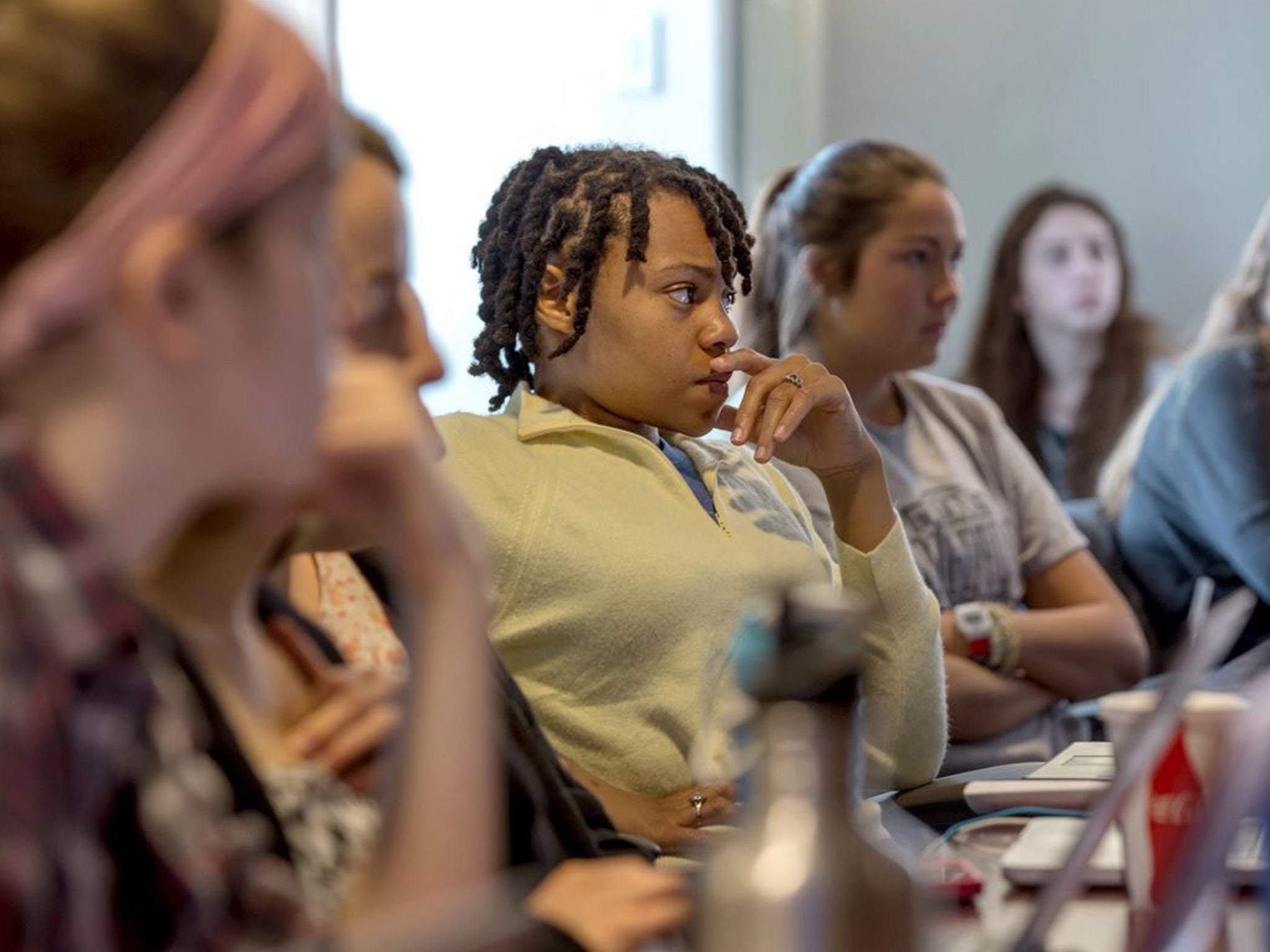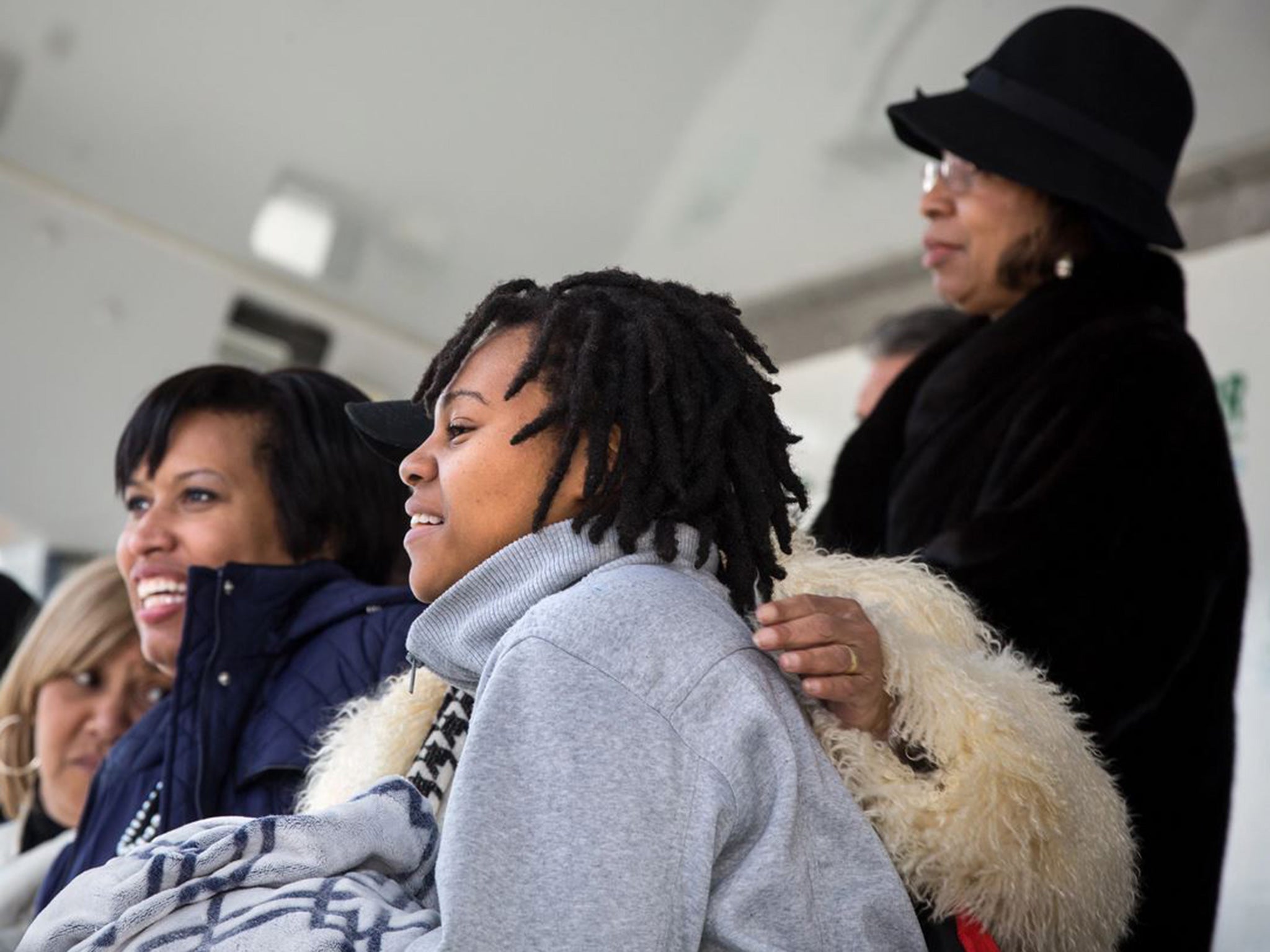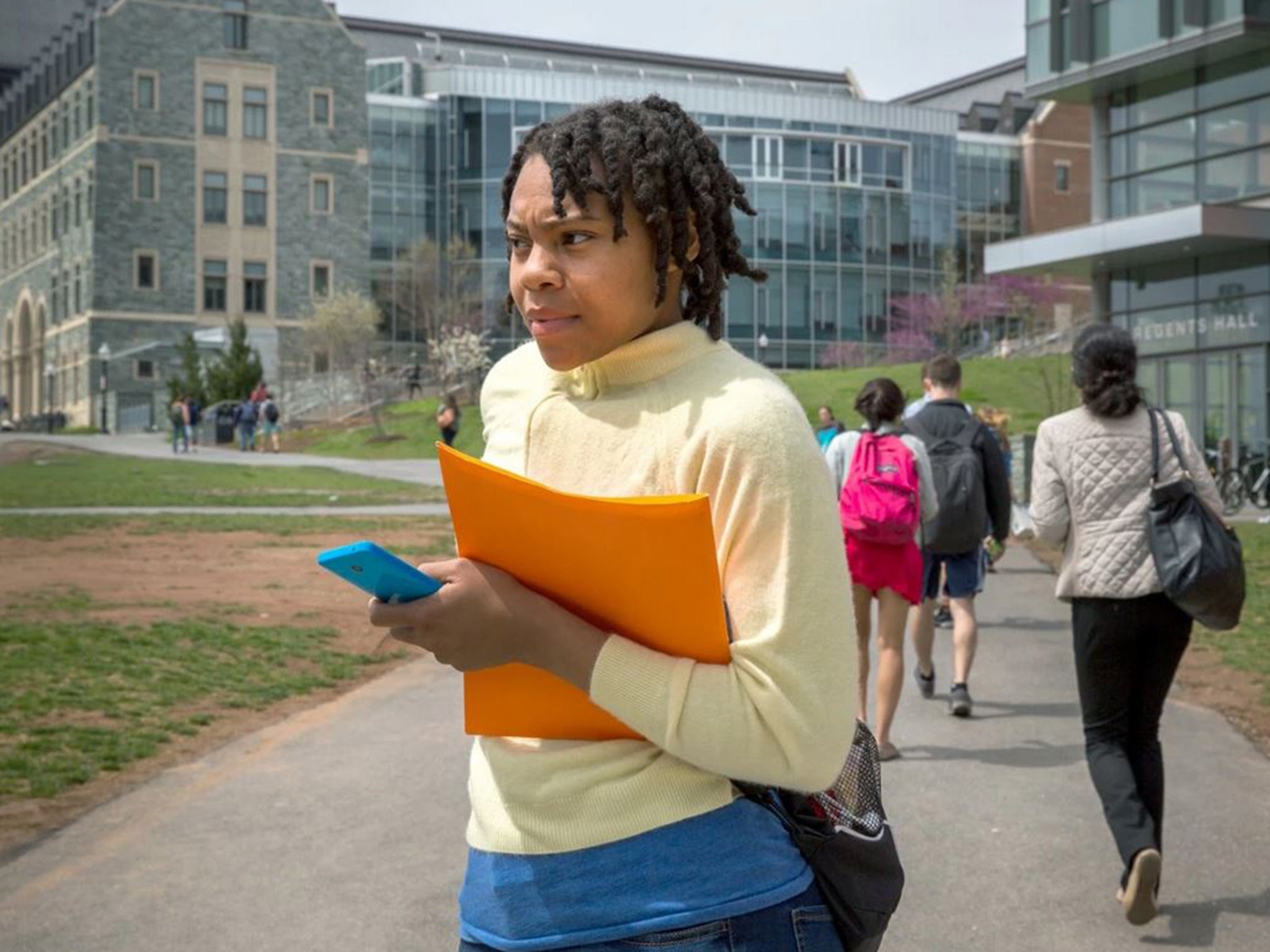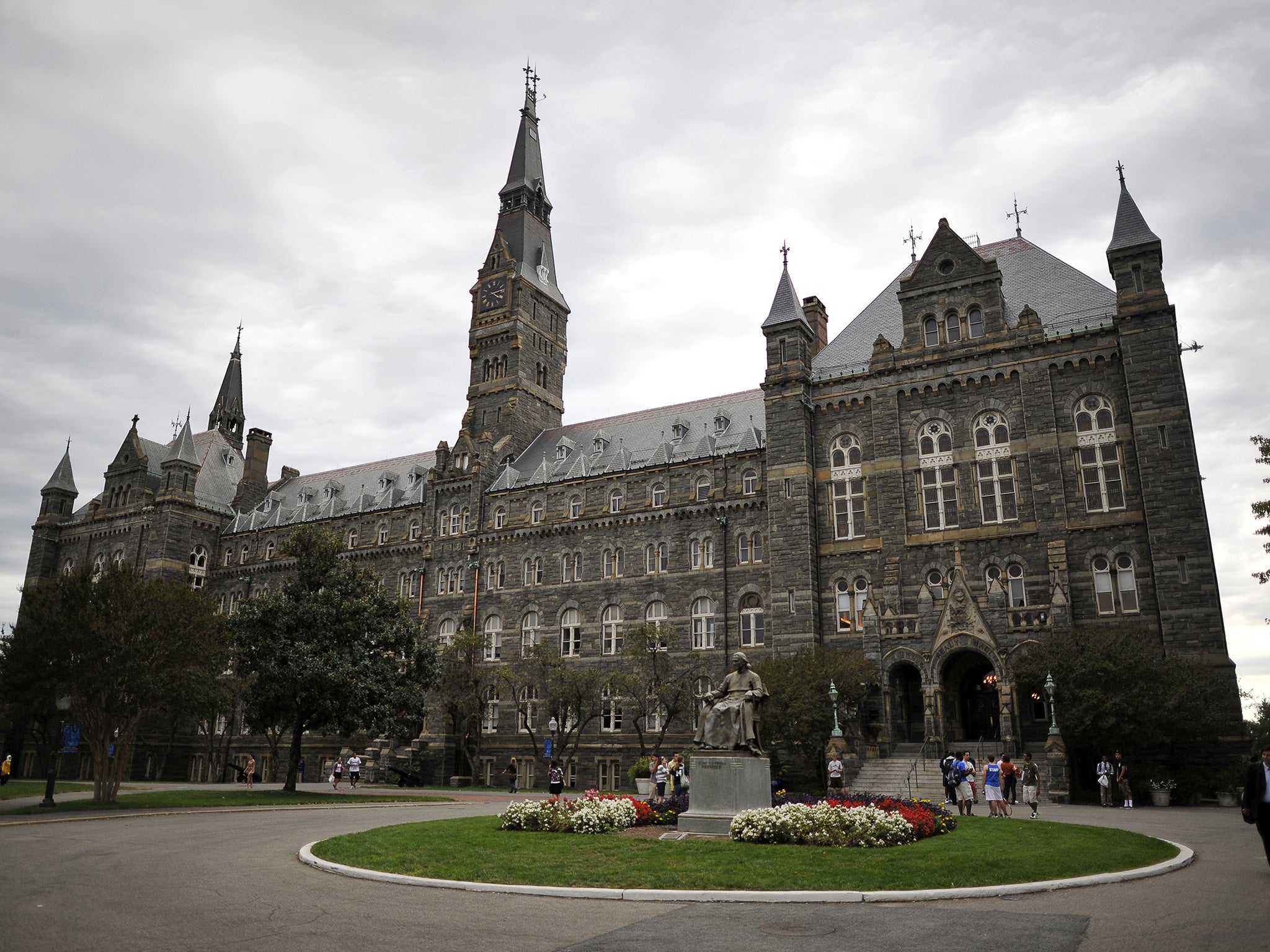How Rashema Melson went from a homeless shelter to Georgetown University
Few students at the elite institution have faced the challenges Rashema did

Your support helps us to tell the story
From reproductive rights to climate change to Big Tech, The Independent is on the ground when the story is developing. Whether it's investigating the financials of Elon Musk's pro-Trump PAC or producing our latest documentary, 'The A Word', which shines a light on the American women fighting for reproductive rights, we know how important it is to parse out the facts from the messaging.
At such a critical moment in US history, we need reporters on the ground. Your donation allows us to keep sending journalists to speak to both sides of the story.
The Independent is trusted by Americans across the entire political spectrum. And unlike many other quality news outlets, we choose not to lock Americans out of our reporting and analysis with paywalls. We believe quality journalism should be available to everyone, paid for by those who can afford it.
Your support makes all the difference.She hated being at the D.C. General homeless shelter, where showers ran cold, raccoons roamed dark hallways and all her stuff was crammed into a chaotic jumble under beds and against pale yellow walls.
There Rashema Melson, 19, had gotten used to sleeping “on plastic and a little wool blanket. No sheets.” For three years, the shelter had been the place she, her mother and siblings called home. It was there, on those same walls, that she had taped her honor roll certificates.
About a year ago, she was standing in her dorm room at Georgetown University, where she had received a scholarship after graduating as valedictorian of Anacostia High School a few months earlier.
She unpacked a loaf of bread and a jar of peanut butter she had saved from a summer academic program. She would not allow herself the luxury of calling her dorm room home.
“Home will come, years later when I finish med school,” she said.
Last summer, as she moved out of the shelter and headed to Georgetown, her family had wished her well. “Don’t worry about us,” her mother had said. “We will be okay.”
Rashema didn’t believe her. “I guess they think my life is going to be better at Georgetown,” she said. “But I’m not going to pretend they are not hurting,” because they were still living in a shelter.

The contrast between the shelter and the dorm room on the elite campus was stark. At the shelter, people carried all their worldly belongings in black garbage bags and borrowed suitcases. At Georgetown, hovering parents would unload well-packed boxes from Mercedes and BMWs in the parking garage.
For the next year, the young woman with the short, twisted hairstyle would navigate both worlds.
Rashema applied for a grant from Georgetown’s Scholarship Program, which helps low-income students adjust to the university, to move into Harbin Hall a week early because she had no other place to go. The shelter, she said, had taken her name off its list of residents when she left for a summer academic program. During the two-week break before returning to campus for the fall semester, she stayed with a friend in Southeast Washington. But after a week, she left.
So on her first night in the dorms, Rashema’s mother and little brother caught a ride across town to the campus. They brought her three packages of ramen noodles and stayed until Rashema fell asleep, about 4 a.m. Then they caught the Metrobus on the 32 route, winding through the city back to the shelter.
The next day, Rashema was on her own. She looked around the dorm room. She had peanut butter, bread and the noodles. “I’m trying to make it stretch, one per day,” she said.
By Tuesday, her third day of noodles, Rashema had to reach out to officials with the Georgetown Scholarship Program. “I asked whether the meal plan could be activated early.”
Not until the following week, she was told. But “the lady gave me some money to get some food,” Rashema said. “It lasted two more days.”
According to the D.C. public school system, Anacostia High School’s graduation rate during 2013-2014 was 58 percent. Sixteen percent of the school’s 661 students took Advance Placement courses.
Only 37 percent of all D.C. students who attend college finish it within six years of high school, according to the D.C. Office of the State Superintendent of Education.
School officials say students who manage to defy the statistics still often have trouble transitioning to competitive universities.
“It is hard. . . . It’s like, ‘Whoa. Where am I?’ ” said Dennis Williams, associate dean of students at Georgetown. Williams runs the Community Scholars program, which helps students from low-income families adjust socially and academically. The five-week summer program requires students to take two courses for credit.
In the fall, the Georgetown Scholarship Program, created 10 years ago to promote more ethnic and socioeconomic diversity on campus, takes over. “Every year, 50 students are invited to participate in the program,” Williams said. “Almost all are from low-income, working-class, single-parent families from urban and rural public schools, places Georgetown doesn’t get a lot of students.”
The program, which has had 600 students participate, becomes a key thread in the safety net “between people in the financial aid office, academic deans’ office, chaplains, counseling,” Williams said.

For Rashema, that meant being assigned a mentor, having someone to help her select classes. For other students it could mean helping a student set up a bank account, pay for train fare home during breaks or buy a coat.
“We realized it was not enough to write a generous scholarship check and hope students get through the next four years,” said Melissa Foy, executive director of the program. “We do a lot of tone-setting, explaining that not only should you not be embarrassed about where you are from, but be proud of it.”
But the differences among the students’ lives are impossible to ignore.
Jawad Pullin, 19, a rising Georgetown sophomore from North Philadelphia, came from a high school that was 99 percent black and a neighborhood that was 95 percent black. At Georgetown, he said, “it felt like a visual imbalance being here.”
He heard students discussing wealth so casually, it felt fantastical. “I heard a kid talking about his New York penthouse that used to be owned by Madonna. He was upset his dad was selling it,” said Pullin, who is attending the university on a Gates Millennium scholarship.
Pullin’s reality couldn’t have been more different. He had to rely on the program to buy him a coat.
Airton Kamdem, 21, a rising junior from Silver Spring, was overwhelmed by invitations to beach houses and lake houses. “I had never been in those kinds of environments,” said Kamdem, whose parents are from Cameroon, where his grandmother still lives with sporadic electricity. “The idea that someone had a house and a second house. . . I asked, ‘Who lives there when you are not here?’ They said nobody.”
Josi Sinagoga, 21, a senior from rural Clinton, Pa., said she walked into a philosophy class and the students were “throwing around names like [Thomas] Hobbes and [Jean-Jacques] Rousseau. That was terrifying. I hadn’t heard of those people before. I realized I was disadvantaged. It was just like another thing I had to beat.”
As much as some students struggled with the adjustment to Georgetown, few students faced the challenges Rashema did, and none of them so publicly.
Her story of moving from homeless shelter to elite university had been covered by various news organizations. Her story, and her face, was well known on the campus.
Her father was killed when she was a baby — the reason she wants to study forensic pathology.
She spent much of her childhood moving from house to house, school to school in the Washington area before her mother moved the family to Ohio when she was in eighth grade.
She detaches herself as she tells the story again:
Rashema, her siblings and mother shared one room. “Two on each bed,” she recalled.

One day, she said, she overheard her mother and the owner of the house arguing in the basement.
Soon, her mother told them they had to leave. “She moved all our household things to storage in Ohio.” Her mother had told her she paid the storage fees for where Rashema packed her favorite books and photos of her father. But Rashema said she suspects her stuff is gone.
A friend later allowed her family to stay at a place he had in Ohio. It was an abandoned building. “There were no lights,” she said. “The toilet would always be stopped up.”
This time the entire family slept in one bed. One morning Rashema awoke with two bruises on her thigh. “They were purple and green,” she said. “ I heard of bed bug bites, but I thought bed bug bites were small. These were bigger than a quarter.”
Her mother took her to the doctor. “But I didn’t have health care in Cincinnati, so they wouldn’t see me,” she said.
Eventually, the wounds turned black and left scars and her mother decided to move again. The family caught a Greyhound bus back to Washington.
At Georgetown, she hears her classmates complain about little things. “I know people who don’t even know how to wash clothes,” she said. “I know how to do things in a situation where I had nothing and I had to turn it into something.”
When she sat in a front desk of her philosophy class second semester, she was aware that people were looking at her.
“People would act like they didn’t know who I was,” she said. “Then I found out they did. I was like, ‘Why didn’t you say something?’ They were like, ‘I didn’t want to be a creep.’ ”
It didn’t help her connect.
In an essay she wrote in December for an English class, she reflected, contrasting her struggles at Georgetown with what she endured living in Anacostia.
“In the perspective of strangers,” she writes, “I was the destined child who became a success story for them to feed off. They believed I was a lucky girl, who had the life every teen should live. The constant straight A’s that were stamped upon my report card, made them see a girl who had knowledge that just came to her easily.
“The strangers felt I should be the poster child for what teens should be, because I was . . . setting examples for America. Once these strangers had a glimpse of what they knew I had endured during my high school life and then some, they made me their success story. Through their eyes they saw a girl who could not be defeated.
“They thought I aced my way through high school, and that I made it look easy. They read about my struggle about being homeless, and believed I was using some secret ability to help me push through. They followed my story and believed in just that, that my life is a story. They watched me fall so many times, only to say that I was an example of how all our knees need to kiss the ground, but our hands should remain reaching for the sky.”
©The Washington Post
Join our commenting forum
Join thought-provoking conversations, follow other Independent readers and see their replies
Comments